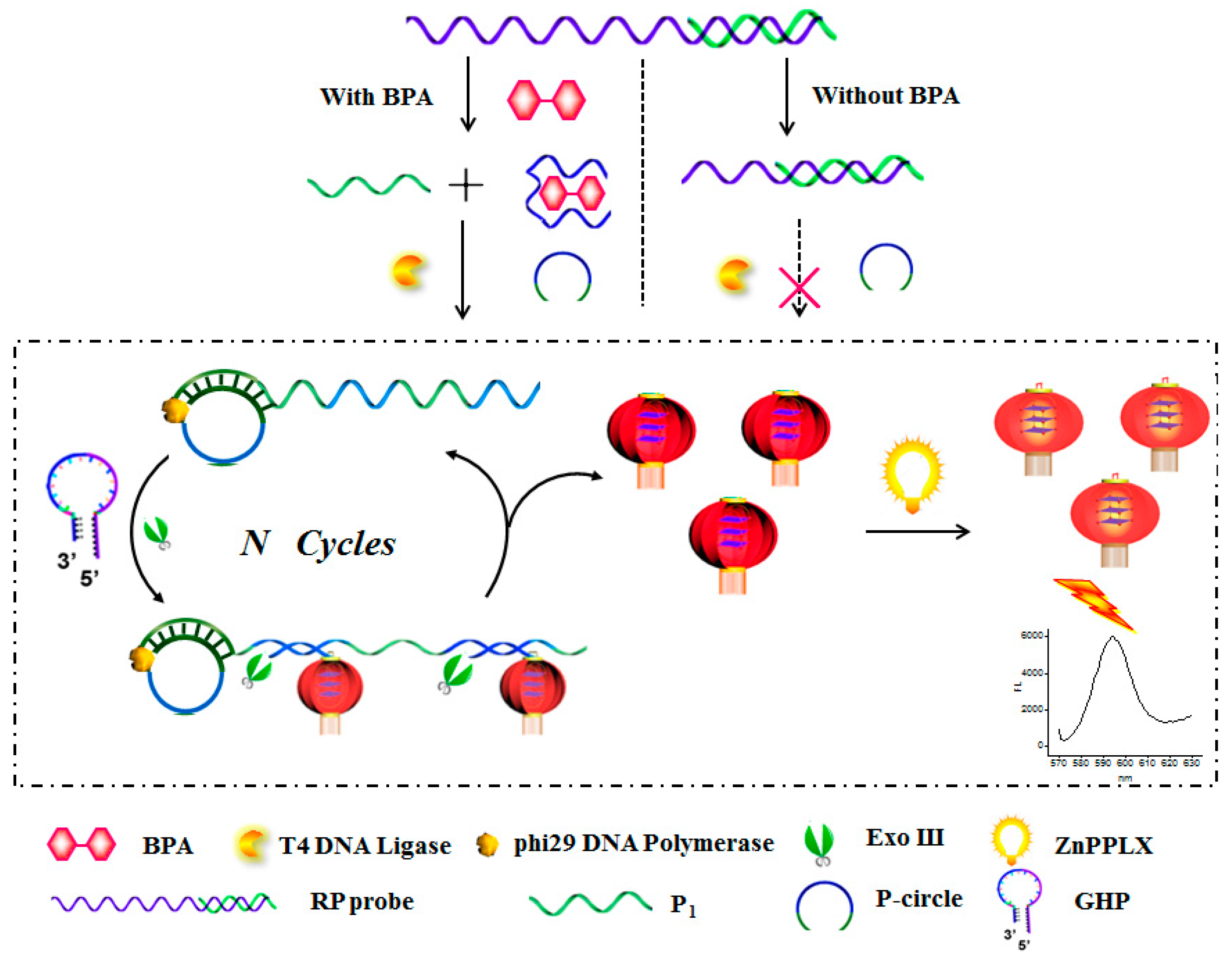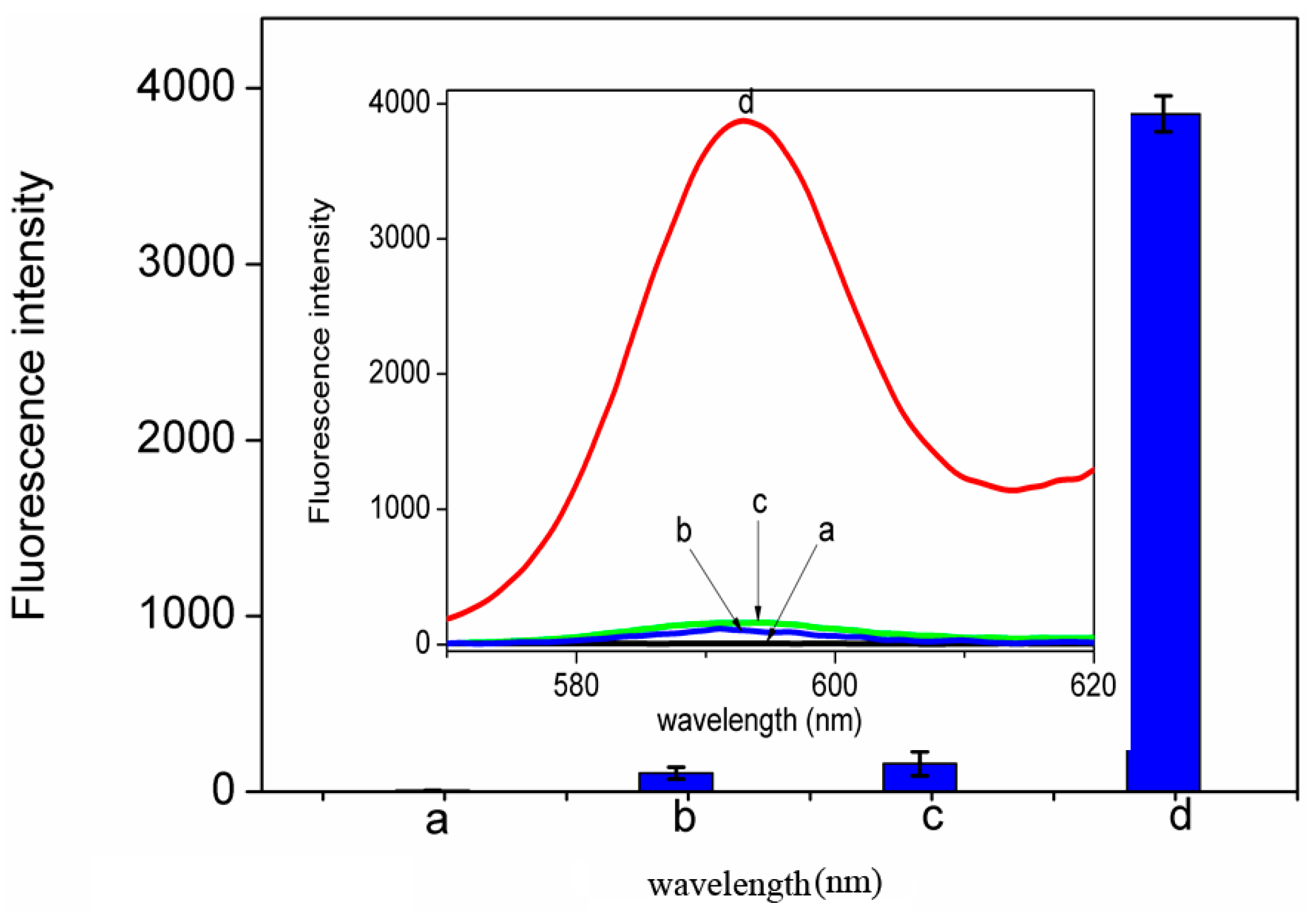A Label-Free and Sensitive Fluorescent Qualitative Assay for Bisphenol A Based on Rolling Circle Amplification/Exonuclease III-Combined Cascade Amplification
Abstract
:1. Introduction
2. Results and Discussion
2.1. The Principle of the RCA/Exo III-Combined Cascade Signal Amplification Platform for BPA Assay
2.2. The Verification of the Designed Sensing System
2.3. Optimizing Parameters to Improve the Assay Performance
2.4. Detection Performance of the Assay
2.5. Selectivity and Real Sample Analysis
3. Materials and Methods
3.1. Chemicals
3.2. Apparatus
3.3. Procedures for DNA Assay
3.4. Analysis of Actual Water Samples
4. Conclusions
Supplementary Materials
Acknowledgments
Author Contributions
Conflicts of Interest
References
- Ragavan, K.V.; Rastogi, N.K. Sensors and biosensors for analysis of bisphenol-A. Trends Anal. Chem. 2013, 52, 248–260. [Google Scholar] [CrossRef]
- Wang, C.; Yang, L.; Wang, S.; Zhang, Z.; Yu, Y.Q.; Wang, M.L.; Cromie, M.; Gao, W.; Wang, S.L. The classic EDCs, phthalate esters and organochlorines, in relation to abnormal sperm quality: A systematic review with meta-analysis. Sci. Rep. 2016, 6, 19982–19993. [Google Scholar] [CrossRef] [PubMed]
- Soto, C.A.; Sonnenschein, C. Environmental causes of cancer: Endocrine disruptors as carcinogens. Nat. Rev. 2010, 6, 363–370. [Google Scholar] [CrossRef] [PubMed]
- Chalasani, R.; Vasudevan, S. Cyclodextrin-functionalized Fe3O4@TiO2: Reusable, magnetic nanoparticles for photocatalytic degradation of endocrine-disrupting chemicals in water supplies. ACS Nano 2013, 7, 4093–4104. [Google Scholar] [CrossRef] [PubMed]
- Benigni, A.; Christopher, J.; Thompson, J.; Ridgeway, M.E.; Park, M.A.; Lima, F.F. Targeted high-resolution ion mobility separation coupled to ultrahigh-resolution mass spectrometry of endocrine disruptors in complex mixtures. Anal. Chem. 2015, 87, 4321–4325. [Google Scholar] [CrossRef] [PubMed]
- Kanso, H.; Barthelmebs, L.; Inguimbert, N.; Noguer, T. Immunosensors for estradiol and ethinylestradiol based on new synthetic estrogen derivatives: Application to wastewater analysis. Anal. Chem. 2013, 85, 2397–2404. [Google Scholar] [CrossRef] [PubMed]
- Ahirwar, R.; Naha, S. In silico selection of an aptamer to estrogen receptor alpha using computational docking employing estrogen response elements as aptamer-alike molecules. Sci. Rep. 2016, 6, 21285–21296. [Google Scholar] [CrossRef] [PubMed]
- Liu, J.C.; Bai, W.H.; Niu, S.C.; Zhu, C.; Yang, S.M.; Chen, A.L. Highly sensitive colorimetric detection of 17β-estradiol using split DNA aptamers immobilized on unmodified gold nanoparticles. Sci. Rep. 2014, 4, 7571–7576. [Google Scholar] [CrossRef] [PubMed]
- Xu, J.Y.; Li, Y.; Bie, J.X.; Jiang, W.; Guo, J.J.; Luo, Y.L.; Shen, F.; Sun, C. Colorimetric method for determination of bisphenol A based on aptamer-mediated aggregation of positively charged gold nanoparticles. Microchim. Acta 2015, 182, 2131–2138. [Google Scholar] [CrossRef]
- Marks, H.L.; Pishko, M.V.; Jackson, G.W.; Cote, G.L. Rational design of a bisphenol A aptamer selective surface-enhanced raman scattering nanoprobe. Anal. Chem. 2014, 86, 11614–11619. [Google Scholar] [CrossRef] [PubMed]
- Li, Y.; Xu, J.Y.; Wang, L.K.; Huang, Y.J.; Guo, J.J.; Cao, X.Y.; Shen, F.; Luo, L.; Sun, C.Y. Aptamer-based fluorescent detection of bisphenol A using nonconjugated gold nanoparticles and CdTe quantum dots. Sens. Actuat. B 2016, 222, 815–822. [Google Scholar] [CrossRef]
- Stojanovic, M.N.; Prad, P.D.; Landry, D.W. Fluorescent sensors based on aptamer self-assembly. J. Am. Chem. Soc. 2000, 122, 11547–11548. [Google Scholar] [CrossRef]
- Zhang, M.; Guan, Y.M.; Ye, B.C. Ultrasensitive fluorescence polarization DNA detection by target assisted exonuclease III-catalyzed signal amplification. Chem. Commun. 2011, 47, 3478–3480. [Google Scholar] [CrossRef] [PubMed]
- Zehani, N.; Fortgang, P.; Lachga, M.S.; Baraket, A.; Sergei, M.A.; Kherra, V.D.R.; Renault, N. Highly sensitive electrochemical biosensor for bisphenol A detection based on a diazonium-functionalized boron-doped diamond electrode modified with a multi-walled carbon nanotube-tyrosinase hybrid film. Biosens. Bioelectron. 2015, 74, 830–835. [Google Scholar] [CrossRef] [PubMed]
- Zuo, X.L.; Xia, F.; Xiao, Y.; Plaxco, K.W. Sensitive and selective amplified fluorescence DNA detection based on exonuclease III-aided target recycling. J. Am. Chem. Soc. 2010, 1132, 1816–1818. [Google Scholar] [CrossRef] [PubMed]
- Ding, Y.J.; Gu, W.; Li, F.; Zhang, H.X.; Qin, W. DNA Nanostructure-based magnetic beads for potentiometric aptasensing. Anal. Chem. 2015, 87, 6465–6469. [Google Scholar] [CrossRef] [PubMed]
- Li, J.; Macdonald, J. Advances in isothermal amplification: Novel strategies inspired by biological processes. Biosens. Bioelectron. 2015, 64, 196–211. [Google Scholar] [CrossRef] [PubMed]
- Zhao, Y.X.; Chen, F.; Li, Q.; Wang, L.H.; Fan, C.H. Isothermal amplification of nucleic acids. Chem. Rev. 2015, 115, 12491–12545. [Google Scholar] [CrossRef] [PubMed]
- Xu, Q.F.; Cao, A.P.; Zhang, L.F.; Zhang, C.Y. Rapid and label-free monitoring of exonuclease III-assisted target recycling amplification. Anal. Chem. 2012, 84, 10845–10851. [Google Scholar] [CrossRef] [PubMed]
- Li, X.; Song, J.; Chen, B.L.; Wang, B.; Li, R.; Jiang, H.M.; Liu, J.F.; Li, C.Z. A label-free colorimetric assay for detection of c-Myc mRNA based on peptide nucleic acid and silver nanoparticles. Sci. Bull. 2016, 61, 276–281. [Google Scholar] [CrossRef]
- Urbanek, C.; Goodison, S.; Chang, M.; Porvasnik, S.; Sakamoto, N.; Li, C.Z.; Boehlein, S.K.; Rosser, C.J. Detection of antibodies directed at M. hyorhinis p37 in the serum of men with newly diagnosed prostate cancer. BMC Cancer 2011, 11, 233–239. [Google Scholar] [CrossRef] [PubMed]
- Liu, M.; Song, J.P.; Shuang, S.M.; Dong, C.; Brennan, J.D.; Li, Y.F. A graphene-based biosensing platform based on the release of DNA probes and rolling circle amplification. ACS Nano 2014, 8, 5564–5573. [Google Scholar] [CrossRef] [PubMed]
- Juul, S.; Nielsen, C.J.F.; Labouriau, R.; Roy, A.; Tesauro, C.; Jensen, P.W.; Harmsen, C.; Kristoffersen, E.L.; Chiu, Y.L.; Frøhlich, R.; et al. Droplet microfluidics platform for highly sensitive and quantitative detection of malaria-causing plasmodium parasites based on enzyme activity measurement. ACS Nano 2012, 6, 10676–10683. [Google Scholar] [CrossRef] [PubMed]
- Hong, C.; Baek, A.; Hah, S.S.; Jung, W.; Kim, D.E. Fluorometric detection of microRNA using isothermal gene amplification and graphene oxide. Anal. Chem. 2016, 88, 2999–3003. [Google Scholar] [CrossRef] [PubMed]
- Chen, J.H.; Zhou, S.G. Label-free DNA Y junction for bisphenol A monitoring using exonuclease III-based signal protection strategy. Biosens. Bioelectron. 2016, 77, 277–283. [Google Scholar] [CrossRef] [PubMed]
- Freeman, R.; Liu, X.Q.; Willner, I. Amplified multiplexed analysis of DNA by the exonuclease III-catalyzed regeneration of the target DNA in the presence of functionalized semiconductor quantum dots. Nano Lett. 2011, 11, 4456–4461. [Google Scholar] [CrossRef] [PubMed]
- Zhang, P.; Wu, X.Y.; Yuan, R.; Chai, Y.Q. An “off–on” electrochemiluminescent biosensor based on DNAzyme-assisted target recycling and rolling circle amplifications for ultrasensitive detection of microRNA. Anal. Chem. 2015, 87, 3202–3207. [Google Scholar] [CrossRef] [PubMed]
- Zhu, Y.; Wang, H.J.; Wang, L.; Zhu, J.; Jiang, W. Cascade signal amplification based on copper nanoparticle-reported rolling circle amplification for ultrasensitive electrochemical detection of the prostate cancer biomarker. ACS Appl. Mater. Interfaces 2016, 8, 2573–2581. [Google Scholar] [CrossRef] [PubMed]
- Xue, Q.W.; Lv, Y.Q.; Zhang, Y.F.; Xu, S.L.; Li, R.; Yue, Q.L.; Li, H.B.; Wang, L.; Gu, X.H.; Zhang, S.Q.; et al. Ultrasensitive fluorescence detection of nucleic acids using exonuclease III-induced cascade two-stage isothermal amplification-mediated zinc (II)-protoporphyrin IX/G-quadruplex supramolecular fluorescent nanotags. Biosens. Bioelectron. 2014, 61, 351–356. [Google Scholar] [CrossRef] [PubMed]





© 2016 by the authors; licensee MDPI, Basel, Switzerland. This article is an open access article distributed under the terms and conditions of the Creative Commons Attribution (CC-BY) license (http://creativecommons.org/licenses/by/4.0/).
Share and Cite
Li, X.; Song, J.; Xue, Q.-W.; You, F.-H.; Lu, X.; Kong, Y.-C.; Ma, S.-Y.; Jiang, W.; Li, C.-Z. A Label-Free and Sensitive Fluorescent Qualitative Assay for Bisphenol A Based on Rolling Circle Amplification/Exonuclease III-Combined Cascade Amplification. Nanomaterials 2016, 6, 190. https://doi.org/10.3390/nano6100190
Li X, Song J, Xue Q-W, You F-H, Lu X, Kong Y-C, Ma S-Y, Jiang W, Li C-Z. A Label-Free and Sensitive Fluorescent Qualitative Assay for Bisphenol A Based on Rolling Circle Amplification/Exonuclease III-Combined Cascade Amplification. Nanomaterials. 2016; 6(10):190. https://doi.org/10.3390/nano6100190
Chicago/Turabian StyleLi, Xia, Juan Song, Qing-Wang Xue, Fu-Heng You, Xia Lu, Yan-Cong Kong, Shu-Yi Ma, Wei Jiang, and Chen-Zhong Li. 2016. "A Label-Free and Sensitive Fluorescent Qualitative Assay for Bisphenol A Based on Rolling Circle Amplification/Exonuclease III-Combined Cascade Amplification" Nanomaterials 6, no. 10: 190. https://doi.org/10.3390/nano6100190




